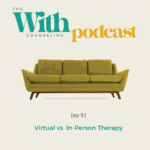
Episode Overview:
In this episode of With Counseling Podcast, JJ Blandford, founder and therapist at With Counseling, discusses the key differences between in-person and virtual therapy. She talks about the pros and cons of each approach and provides guidance on how to decide which one might be the best fit for your needs.
Key Topics:
-
The Shift to Virtual Therapy (Post-COVID)
- Therapy was traditionally in-person, but the pandemic accelerated the adoption of virtual therapy.
- JJ shares her personal experience of transitioning from in-person to virtual therapy during the pandemic and how it changed his practice.
- While in-person therapy has its advantages, virtual therapy has become a feasible and often preferred option for many clients.
-
Advantages of In-Person Therapy:
- Connection: In-person sessions allow therapists to pick up on body language, nonverbal cues, and the “vibes” in the room, which can create a deeper connection.
- Safe Environment: The office provides a neutral, safe space where clients can focus on therapy without distractions or worries about being overheard.
- Therapy for Children: In-person therapy, especially with kids, allows for activities like play therapy, which is difficult to replicate virtually.
-
Benefits of Virtual Therapy:
- Convenience: Virtual therapy eliminates the need for commuting, saving time and making it easier for clients to schedule sessions.
- Accessibility: Clients can access therapy from the comfort of their own homes or even on their lunch breaks.
- Flexibility: Virtual therapy provides more options for clients, particularly those in rural areas or places where therapy resources are limited.
- Comfort: Many clients find virtual therapy less intimidating as they can participate in a familiar, private space, making it easier to open up.
-
Challenges of Virtual Therapy:
- While virtual therapy works for many, it can feel less personal, and some clients may struggle with the absence of physical presence and the emotional “vibe” of the room.
- For therapists, translating in-person therapy skills to an online platform took some adjustment.
-
Choosing the Right Therapy Option:
- Consider what you need from therapy: Is convenience more important to you, or do you feel that face-to-face interaction is essential?
- Practical Considerations: What fits your schedule? Are you open to virtual therapy or do you prefer the structure of in-person sessions?
- Emotional Comfort: Some clients may feel more at ease with virtual therapy, especially if they experience anxiety about going to an office.
-
The Role of Virtual Therapy in Expanding Access:
- Virtual therapy helps clients find therapists who align with their personal values, beliefs, or identity, especially if local options are limited.
- It also broadens the search area for clients who need specialized care that may not be available in their geographic region.
-
Tips for Choosing Between In-Person and Virtual Therapy:
- Consider your lifestyle: Can you fit therapy into your schedule with travel time?
- Use online directories: Sites like Psychology Today allow you to filter by virtual or in-person options, insurance, gender, language spoken, etc.
- Referrals: Ask friends or colleagues for therapist recommendations to help narrow your options.
- Evaluate profiles and videos: Reading therapist profiles or watching introductory videos can give you a better idea of their approach and help you make a more informed decision.
-
Final Thoughts:
- Both in-person and virtual therapy have their unique benefits. It’s important to be open to either option depending on your needs and what works best for your situation.
- Whether you prefer virtual or in-person therapy, the key is to take that first step toward seeking help.
Actionable Advice:
- If you’re considering therapy, take a moment to reflect on what you need and whether convenience or personal connection is a higher priority for you.
- Explore both virtual and in-person options, and reach out to a therapist who resonates with your needs.
- Don’t hesitate to try a session or two virtually—it may turn out to be a great fit, and you’ll have flexibility in finding the right match.
Closing:
JJ wraps up by encouraging listeners to find a therapist who feels like a good fit, whether in-person or virtual, and to not let barriers like logistics or anxiety stop them from seeking help.
Follow JJ Blandford:
- Connect on Facebook and Instagram: @CounselingWith
- Visit the website for more resources: CounselingWith.com
